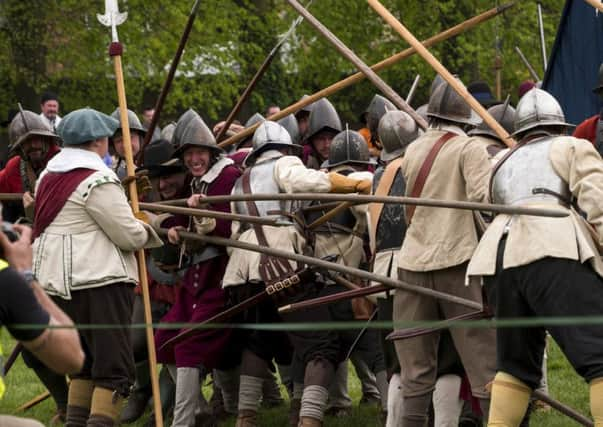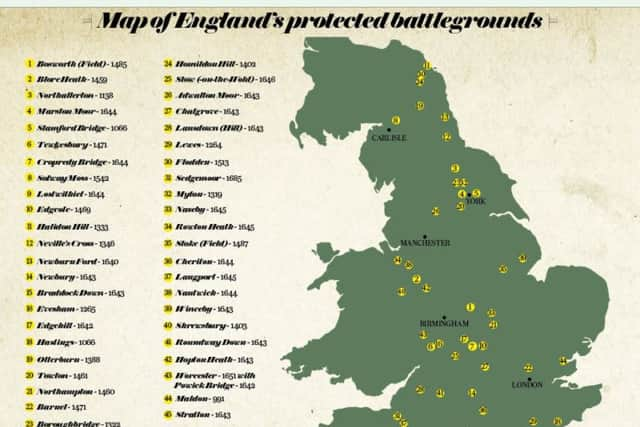England's historic battlefields mapped


This article contains affiliate links. We may earn a small commission on items purchased through this article, but that does not affect our editorial judgement.
Factions battling over territory and the right to rule the nation have clashed the length and breadth of the country, leaving their mark on every region.
So if you want to know the who, the when and the why of battles in your area and their significance in England’s history read on below where we’ve mapped out the 45 sites classed as protected under the Historic England listing system.
1 Battle of Bosworth (Field) 1485
Advertisement
Hide AdAdvertisement
Hide Ad

The battle of Bosworth was the last major engagement in the Wars of the Roses. In one of history’s most staggering reversals, the royal army lost to a rebel force half its size, leaving King Richard III dead and allowing Henry Tudor to claim the throne as Henry VII.
Location: Stoke Golding, Leicestershire
2 Battle of Blore Heath 1459
One of the first battles in the Wars of the Roses between the Houses of York and Lancaster. Royalist forces were sent by the Queen to intercept the Earl of Salisbury’s troops on their march to join with the Duke of York’s army at Ludlow. The battle was a decisive victory for the Yorkist soldiers.


Location: Bloreheath, Market Drayton, Staffordshire
3 Battle of Northallerton 1138
Also know as the Battle of the Standard, this engagement came about when King David of Scotland sought to enter England to support his niece Matilda’s claim to the throne over King Stephen. The Scottish army, led by David were quickly repelled by English forces raised by Archbishop Thurstan of York.
Location: Standard Hill, Northallerton, North Yorkshire
4 Battle of Marston Moor 1644
Thought to be the largest battle ever fought on English soil, with around 46,000 combatants. This Civil War battle saw the defeat of Prince Rupert’s northern Royalist army by the Parliamentarian forces of Oliver Cromwell. The rout of the Royalist army help cement Cromwell’s reputation as a great leader.
Location:Wilstrop, Harrogate, North Yorkshire
5 Battle of Stamford Bridge 1066
Advertisement
Hide AdAdvertisement
Hide AdThe Battle of Stamford Bridge was fought between the armies of the English king Harold Godwinson and and the joint forces of his brother Tostig and Norway’s King Harald Hardrada, who hoped to claim the English throne for himself. The Vikings suffered heavy losses and were soundly beaten but the battle in Yorkshire left Harold’s forces ill-prepared to face William of Orange’s army at Hastings just three weeks later.
Location: Stamford Bridge, East Riding of Yorkshire
6 Battle of Tewkesbury 1471
A key episode in the Wars of the Roses, the Battle of Tewkesbury brought decisive victory to the Yorkists. With the Lancastrian heir Edward, Prince of Wales dead along with many of his noblemen the Yorkist Edward IV was free to reign in peace until his death in 1483.
Location: Wheatpieces, Tewkesbury, Gloucestershire
7 Battle of Cropredy Bridge 1644
The Battle of Cropredy Bridge saw an opportunist strike by Roundhead forces under Sir William Waller against King Charles’ army as it marched from Oxford. Although Waller got the initial upper hand the Royalist forces managed to fight back and suffered minimal losses while forcing the Parliamentarians to retreat.
Location: Cropredy, near Banbury, Oxfordshire
8 Battle of Solway Moss 1542
Fought on Solway Moss, near the River Esk after Scottish forces representing James V marched into England in response to an English raid north of the Border. Despite vastly superior numbers the Scottish army was disorganised and poorly led and the English quickly overcame them. Three weeks later James died, leaving the two-week-old Mary as Queen.
Location: Arthuret, Carlisle, Cumbria
9 Battle of Lostwithiel 21 August 1644
Advertisement
Hide AdAdvertisement
Hide AdA battle in two phases between the Royalist and Parliamentarian armies during the First Civil War, regarded as a vital victory for the king’s army. The first engagement, on 21 August saw King Charles’ troops attack the depleted force of the Earl of Essex and capture Restormel Castle. From here, on 31 August to 1 September, they pursued and captured thousands of retreating Parliamentarians.
Location: St. Winnow, Cornwall
10 Battle of Edgcote 1469
The first major engagement in the second period of the Wars of the Roses. Troops led by the Earl of Pembroke, on their way to join with Edward IV at Nottingham, encountered a rebel force led Robin of Redesdale. The battle saw the rebel army defeat Pembroke’s men and few days later the King himself was captured, effectively handing control to the Earl of Warwick.
Location: Culworth, Northamptonshire
11 Battle of Halidon Hill 1333
Part of the Second War of Scottish Independence and a crushing loss for the Scots. In an attempt to relieve the siege of Berwick around 15,000 Scottish soldiers engaged with the English forces of Edward III but suffered heavy losses on unfavourable terrain. After the Scots’ loss Berwick and the lands of the Borders and Lothians were ceded to England.
Location:Halidon Hill, Berwick-upon-Tweed, Northumberland
12 Battle of Neville’s Cross 1346
A key engagement between the English and Scottish armies during the Second War of Scottish Independence. The battle was disastrous for the Scots, many leading noblemen fled or were killed and King David II was wounded and captured. In the year following the battle the English took advantage of the Scots’ depleted strength to capture almost the whole of Scotland south of the Forth and Clyde.
Location: Bearpark, County Durham
13 Battle of Newburn Ford 1640
Advertisement
Hide AdAdvertisement
Hide AdThe only battle in the Second Bishops War but regarded of significant importance for its wider political impact. A vastly outnumbered English force was routed by the Scottish army, which two days later accepted the surrender of Newcastle. The ensuing recall of parliament and conflicts there eventually led to the Civil War.
Location: Newcastle upon Tyne
14 Battle of Newbury 1643
Fought during the First Civil War. As the Earl of Essex tried to march his Parliamentarian troops back to London after victory in Charles I led his forces to intercept them. The Roundheads